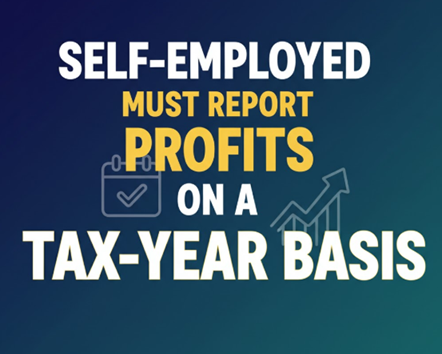-
News
-
Blog
-
Archive

If you're a sole trader or in a partnership, the way you report profits has changed. From the 2024/25 tax year onwards, everyone is taxed on profits that fall in the tax year itself (6 April to 5 April), not on the profits for your own accounting year unless your year-end. already lines up with 31 March/5 April.
What changed
Before now, many self-employed people used the “current year” method: you were taxed on the profits for your accounting year that ended in the tax year. If your accounts ended on, say, 30 September, your 2023/24 tax return used the year to 30 September 2023.
From 2024/25, HMRC wants everyone on a tax-year basis. That means you report the profit that arises between 6 April and 5 April, no matter what your chosen accounting year end is.
There was a one-off transition year in 2023/24 to move everyone across. In that year HMRC let you use any overlap relief you had and spread extra profits (if any) over up to five tax years to smooth the impact.
What it means for you now
- If your accounting year already ends 31 March or 5 April: very little changes. Your accounts still match the tax year.
- If your year end is anything else (e.g., 30 June, 30 September, 31 December): each return must apportion profits, so they fit the tax year window.
- You add together the right slices from two sets of accounts to cover 6 April to 5 April.
- If your second set of accounts isn't ready at filing time, you can use a reasonable estimate and amend later.
Cash-flow note: Spreading rules from 2023/24 helped with the switch, but ongoing apportionment may change your payments on account timing. Keep an eye on this so there are no surprises.
A quick example
You keep a 30 September year end.
- For 2024/25, you report:
- 6 April–30 September 2024: 6/12 of your year to 30 Sep 2024
- 1 October 2024–5 April 2025: 6/12 (plus 5 days) of your year to 30 Sep 2025
Add those parts together—that's the profit for your 2024/25 tax return.
If you filed before the 2025 accounts were final, you'd estimate that second slice and amend once the figures are ready.
What to do next (and keep life simple)
- Decide on year end: switch to 31 March/5 April to avoid annual apportionment or keep your existing date and plan for the split each year.
- Keep monthly records: a decent bookkeeping app and bank feeds make apportionment (or a switch of year-end) much easier.
- Watch payments on account: changes in timing can affect how much you pay and when.
- Use the transition reliefs correctly: if you still have adjustments from 2023/24, make sure they're carried forward as intended.
- Ask for help early: getting estimates, amendments and cash-flow right is easier if you plan across the year, not at the deadline.
You can read HMRC's overview of the rules on HMRC
Final thought
The move to a tax-year basis aims to make reporting clearer and fairer, but it can change when you pay tax especially if your year-end isn't 31 March/5 April. If you'd like someone to set up a simple schedule, handle apportionments, and map out your cash-flow, our Bolton Accountants team can help with Business planning and forecasts, so you always know what's coming.